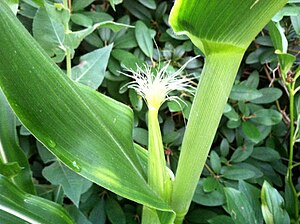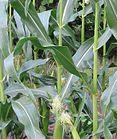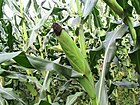Note: This is a project under development. The articles on this wiki are just being initiated and broadly incomplete. You can Help creating new pages.
Zea mays
Zea mays is an erect, robust, usually unbranched annual plant. It can grow up to 6 metres tall but is more likely to around 2 metres with cultivars that can range from around 1 metre up to 3 metres or more. Maize is one of the most commonly cultivated crops in the world, providing a range of foods including popcorn, sweetcorn and a grain that can be ground into a flour. It was first domesticated in the Americas around 4,000 BC, but its cultivation has since spread to most parts of the world.
Uses
Strangury, Dysuria, Diabetes, Gonorrhoea, Gout, Cystitis, Nose bleeds, Menorrhagia, Ulcers, Swellings, Rheumatic pains.[1]
Parts Used
Chemical Composition
Chemical constituents of corn grains are total P mg/g, total N mg/g, crude protein %, carbohydrate %, T.S.S. %, starch % and oil etc.[2]
Common names
| Language | Common name |
|---|---|
| Kannada | |
| Hindi | |
| Malayalam | |
| Tamil | |
| Telugu | |
| Marathi | |
| Gujarathi | |
| Punjabi | |
| Kashmiri | |
| Sanskrit | |
| English |
Properties
Reference: Dravya - Substance, Rasa - Taste, Guna - Qualities, Veerya - Potency, Vipaka - Post-digesion effect, Karma - Pharmacological activity, Prabhava - Therepeutics.
Dravya
Rasa
Guna
Veerya
Vipaka
Karma
Prabhava
Habit
Identification
Leaf
| Kind | Shape | Feature |
|---|---|---|
Flower
| Type | Size | Color and composition | Stamen | More information |
|---|---|---|---|---|
| {{{5}}} |
Fruit
| Type | Size | Mass | Appearance | Seeds | More information |
|---|---|---|---|---|---|
Other features
List of Ayurvedic medicine in which the herb is used
Where to get the saplings
Mode of Propagation
How to plant/cultivate
Plants grow well in lowland tropical areas and can succeed at elevations up to 2,000 metres.[4]
Commonly seen growing in areas
[[:Category:Herbs that are commonly seen in the region of |]], [[:Category:Herbs that are commonly seen in the region of |]], [[:Category:Herbs that are commonly seen in the region of |]], [[:Category:Herbs that are commonly seen in the region of |]], [[:Category:Herbs that are commonly seen in the region of |]].
Photo Gallery
References
- ↑ Indian Medicinal Plants by C.P.Khare
- ↑ Chemical constituents
- ↑ [Morphology]
- ↑ Cultivation
External Links
- Ayurvedic Herbs known to be helpful to treat Strangury
- Ayurvedic Herbs known to be helpful to treat Dysuria
- Ayurvedic Herbs known to be helpful to treat Diabetes
- Ayurvedic Herbs known to be helpful to treat Gonorrhoea
- Ayurvedic Herbs known to be helpful to treat Gout
- Ayurvedic Herbs known to be helpful to treat Cystitis
- Ayurvedic Herbs known to be helpful to treat Nose bleeds
- Ayurvedic Herbs known to be helpful to treat Menorrhagia
- Ayurvedic Herbs known to be helpful to treat Ulcers
- Ayurvedic Herbs known to be helpful to treat Swellings
- Ayurvedic Herbs known to be helpful to treat Rheumatic pains
- Herbs with Leaves used in medicine
- Herbs with Roots used in medicine
- Habit - Annual
- Index of Plants which can be propagated by Seeds
- Herbs that are commonly seen in the region of
- Herbs







